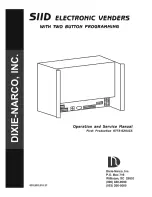
Explanations of basic screens, keys and operations
Explanation of operations
Stitching operations
(1) Reconfirm the stitching data before starting. Take special care to the set stitching speed.
(2) The stitching speed is determined according to the set speed and stitch length. The maximum
stitching speed is determined by the speed setting, and the stitch length limits the stitching speed.
[Caution] Do not change the sewing machine stitching speed during operation except in
emergencies. (Changing the speed can cause fault such as thread catching faults.)
(3) Set the material to be stitched, and turn the work holder switch ON. Next, when the start switch is
turned ON, the sewing machine will start rotating and stitching. Once started, stitching will continue
even the operator's foot is released from the start switch. When the stitching is completed, and the
work holder returns to the home position, the sewing machine will stop and the work holder will
automatically rise.
Halting
To stop during the stitching, press the HALT switch (installed on sewing machine head; refer to
following drawing). The sewing machine will stop at the needle UP position. (Standard default setting.)
To cancel the halted state, turn the HALT switch in the direction of the arrow. The following operations
will be possible when the halted state is canceled.
(1) Restart of stitching by pressing start switch (gray pedal)
(2) Movement to stitching start position with forward jog/reverse jog keys.
(3) Lifting of work holder by pressing work holder switch (black pedal)
(4) Change of stitching speed by setting stitching speed
(5) Lifting/lowering of presser bar lifting
[Caution] The needle position during the halted state can be set with the program mode
from the setting screen.
HALT switch
[Sewing machine head]
[3]-5
Summary of Contents for PLK-E Series
Page 2: ......
Page 13: ...Explanations of basic screens keys and operations 3 6...
Page 15: ...Stitching data type and writing No 4 1...
Page 21: ...Reading writing and erasing data floppy disk 5 5...
Page 26: ...Reading writing and erasing data internal memory 6 4...
Page 28: ...7 1...
Page 35: ...Creating simple stitching data 8 6...
Page 39: ...Methods of creating stitching data 9 3...
Page 44: ...Methods of creating stitching data 9 7...
Page 54: ...Methods of creating stitching data 9 15...
Page 58: ...Methods of creating stitching data 9 22...
Page 63: ...Methods of creating stitching data 9 26...
Page 68: ...Methods of creating stitching data 9 30...
Page 72: ...Methods of creating stitching data 9 33...
Page 75: ...Methods of creating stitching data 9 35...
Page 79: ...Methods of creating stitching data 9 38...
Page 86: ...Modification mode 12 5...
Page 89: ...Modification mode 12 7...
Page 94: ...Modification mode 12 11...
Page 99: ...Modification mode 12 15...
Page 104: ...Modification mode 12 19...
Page 111: ...Modification mode 12 25...
Page 115: ...Modification mode 12 28...
Page 122: ...Modification mode 12 34...
Page 126: ...Modification mode 12 37...
Page 133: ...Modification mode 12 43...
Page 138: ...Modification mode 12 47...
Page 143: ...Modification mode 12 51...
Page 148: ...Modification mode 12 55...
Page 155: ...Data conversion mode 13 6...
Page 158: ...Data conversion mode 13 8...
Page 162: ...Data conversion mode 13 11...
Page 166: ...Data conversion mode 13 14...
Page 169: ...Data conversion mode 13 16...
Page 179: ...Data conversion mode 13 25...
Page 204: ...Program mode 16 5...
Page 205: ...Program mode 16 6...
Page 208: ...Program mode list 17 2...












































